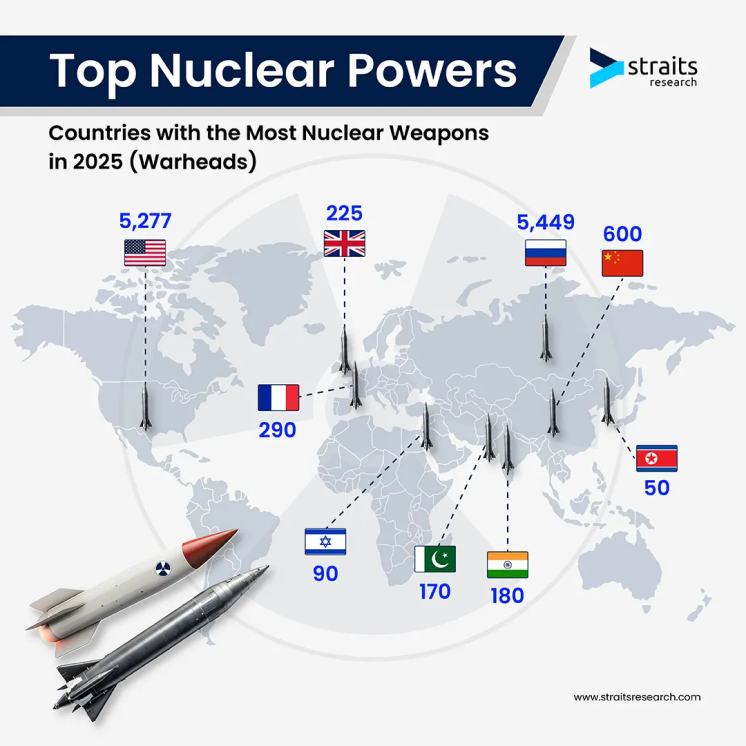Countries with Most Nuclear Weapons in 2025

As of early 2025, the world is home to an estimated 12,241 nuclear weapons, an important reminder that nuclear deterrence remains central to global security strategies. Although this number reflects a significant reduction from Cold War-era figures, down from over 60,000 warheads in the 1980s, the current stockpile nevertheless poses a serious threat to global peace, public health, and the environment.
Countries with the Most Nuclear Weapons
Nine countries currently possess the most nuclear weapons, led by Russia with 5,449 warheads and the United States with 5,277. Together, these two powers hold more than 88% of the world's nuclear stockpile. China follows distantly with 600 warheads, while France and the United Kingdom maintain 290 and 225, respectively. In South Asia, India holds 180 warheads and Pakistan 170.
Israel, though undeclared, is estimated to possess around 90 warheads, and North Korea, despite international sanctions, maintains an arsenal of about 50. Additionally, six nations host nuclear weapons without owning them, which are Italy (35), Turkiye (20), Belgium, Germany, and the Netherlands (15 each), all under U.S. command through NATO arrangements, and Belarus, which hosts Russian weapons of unspecified quantity.
Moreover, strong industrial networks are responsible for the creation and maintenance of these weapons. Twenty big businesses in all support nuclear weapons development in the United States, the United Kingdom, France, and India. Eleven American companies, including Lockheed Martin, Boeing, Honeywell International, and Northrop Grumman, are among them. India's main player is Larsen & Toubro, France depends on Safran and Thales, while the United Kingdom provides companies like BAE Systems and Rolls-Royce. Through alliances like MBDA and AWE, these businesses assist a variety of tasks, from modernising warheads to building submarines.
Nuclear Spending Surge
Global spending on nuclear weapons jumped to over $100 billion in 2024, a 32% increase over the preceding five years and a dramatic 11% increase from the year before. That comes out to about $190,151 per minute. Outspending all other nuclear nations combined, the United States alone spent $56.8 billion. With $12.5 billion and $10.4 billion, respectively, China and the UK came next. Nuclear-related contracts brought in at least $42.5 billion for private contractors, of which $20 billion came from new contracts. Notably, $128 million was used to support these projects through lobbying in France and the United States.
While some nations argue that nuclear modernisation is essential for maintaining a credible deterrent, critics point to the opportunity costs. For instance, the $100 billion spent globally on nuclear weapons could have funded vital initiatives in healthcare, education, and climate change. That sum alone could cover the United Nations' annual budget 28 times over. Life Extension Programs (LEPs) and warhead upgrades to improve security and functioning are two examples of modernisation initiatives that are very active in the US under the Department of Energy's National Nuclear Security Administration (NNSA). Similar initiatives are being carried out in China, Russia, and other nuclear-armed countries.
The frequency of nuclear testing has declined since the Cold War, despite widespread concern. But past evidence is still disturbing. The U.S. has conducted 1,032 tests between 1945 and 1992, followed by the Soviet Union/Russia with 715, France with 210, and both the U.K. and China with 45. India and North Korea have each carried out six tests, while Pakistan has conducted two.
Furthermore, the history of nuclear weapons has also been marred by accidents. 32 "Broken Arrows," or documented nuclear weapons incidents, have occurred in the United States, including the loss of six warheads that were never recovered. Notable incidents that show the continuous dangers of nuclear weapons are the 1961 B-52 crash in North Carolina and the 1965 Titan II missile explosion in Arkansas.
The Treaty on the Prohibition of Nuclear Weapons (TPNW) and the Nuclear Non-Proliferation Treaty (NPT) are two examples of international disarmament initiatives that have gathered momentum. There are 191 state parties to the NPT; however, South Sudan, Israel, Pakistan, and India are not included in its framework. In 2003, North Korea pulled out. Over 700 groups and 98 nations have endorsed the TPNW, showing the growing opposition to nuclear weapons around the world.
The majority of nuclear-armed nations, however, are updating rather than cutting their stockpiles, suggesting a possible new arms race driven by escalating geopolitical tensions, ranging from North Korea and the India-Pakistan border to Ukraine and Gaza. Public opinion is still split in this situation, weighing reliance on prevention against the horror of nuclear war. The world must manage current threats while working toward long-term disarmament and peace as nuclear power advances and spending increases dramatically.




